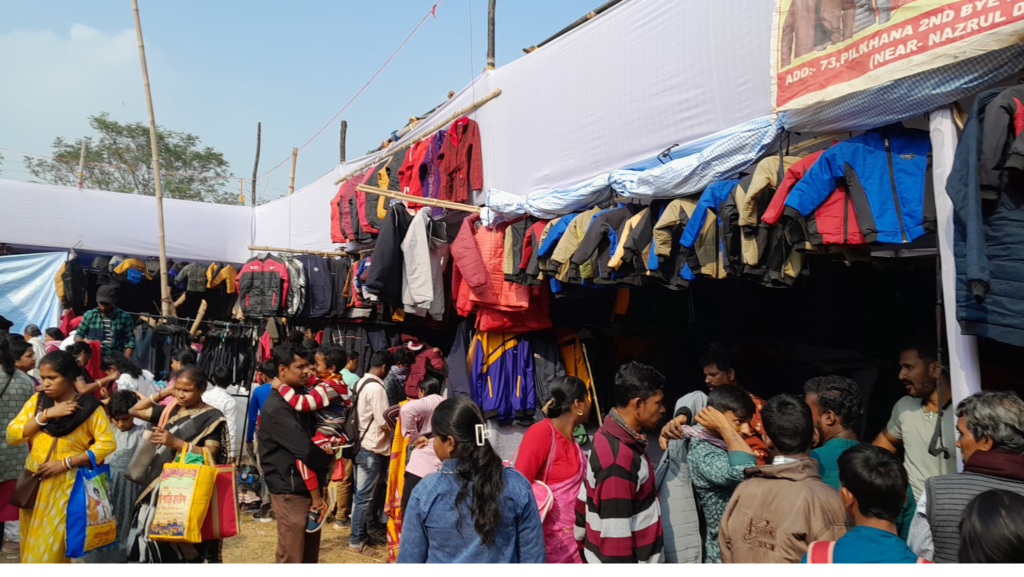Poush Mela: Discover the Cultural Splendor of Santiniketan, West Bengal

The Poush Mela's Origins and History
On December 21, 1843, Maharshi Devendranath Tagore, the father of Rabindranath Tagore, embraced the Brahmo creed, marking the beginning of the Poush Mela story. Under the direction of Ramchandra Vidyabagish, he adopted this new spiritual philosophy along with twenty other adherents. On December 21, 1891, the Brahma Mandir (Brahmo Temple) was founded in remembrance of this occasion. A modest celebration to commemorate the temple’s anniversary has expanded into a sizable fair that draws thousands of tourists from all over India and beyond.
When is Poush Mela Celebrated?
Poush Mela officially begins on December 23rd, which is the 7th day of the Bengali month Poush. The day starts with the soulful notes of the shehnai resonating through the serene landscape of Shantiniketan. While the fair itself runs for three days, vendors and artisans often keep their stalls open until the month of Poush ends. The celebration not only marks the harvest season but also celebrates unity, creativity, and Bengal’s rich cultural history.
Cultural Events and Activities at Poush Mela
Poush Mela brings together art, music, and tradition in a way that creates an unforgettable experience for visitors. Here’s a glimpse of the key events and activities:
- Morning Procession and Prayer: The day begins with the Vaitalik group singing melodious songs and walking around the ashram with traditional instruments. This is followed by a prayer meeting at Chhatimtala, an open space beneath sacred trees.
- Baul Music Performances: One of the highlights of Poush Mela is the live Baul music. The Bauls are wandering minstrels of Bengal who sing soulful folk songs accompanied by instruments like the ektara. Their music adds an authentic rural charm to the fair.
- Tribal Dances and Folk Performances: The mela comes alive with vibrant tribal dances and folk performances that showcase Bengal’s rich cultural diversity. Visitors can witness tribal sports and other traditional activities.
- Rabindra Sangeet and Dance: Students of Visva-Bharati University showcase their talent by performing graceful dances to Rabindra Sangeet (songs by Rabindranath Tagore), enriching the festive spirit.
With over 1,500 stalls and around 10,000 visitors each year, Poush Mela is not just a fair; it’s a grand celebration of culture and unity.
Shopping at Poush Mela: A Treasure Trove of Handicrafts
If you’re an art lover or a fan of handmade items, Poush Mela is a paradise. The fair is a showcase of Bengal’s rich heritage, offering a variety of traditional handicrafts and artwork:
- Handicrafts: Stalls feature mud artifacts, pottery, wooden combs, clay toys, and decorative showpieces that make for unique souvenirs.
- Madhubani and Patachitra Art: Art lovers can explore Madhubani paintings from Bihar and Patachitra artworks from Bengal, both famous for their intricate designs.
- Textiles: Shoppers can indulge in Batik-printed kurtas, sarees, bags, and Kantha stitch garments adorned with colorful hand embroidery.
- Books: Rabindranath Tagore’s works are a highlight, with book stalls offering a wide collection of his literature, along with rare tribal literature and art books.
The fair offers something for everyone—be it art, culture, or shopping.

Food Delights at Poush Mela
Poush Mela is a food lover’s delight, offering a wide variety of traditional Bengali dishes and sweets. Here are some must-try items:
- Traditional Bengali Sweets: Indulge in classics like Malpua, Patishapta (thin pancakes filled with jaggery and coconut), Moa (puffed rice and jaggery), and Tiler Khaja (sesame seed brittle).
- Special Dishes: Don’t miss Chanar Payesh, a creamy pudding made of cottage cheese, jaggery, and sugar.
- Fast Food and Snacks: Food stalls selling rolls, parathas, and savory chicken dishes remain popular and busy throughout the day.
- Homemade Pickles: Various types of tangy homemade pickles are available, adding a unique flavor to the fair.
With its wide array of sweet treats, snacks, and hearty meals, Poush Mela is a culinary journey you don’t want to miss.
Accommodation Options in Shantiniketan During Poush Mela
As Poush Mela attracts thousands of tourists, Shantiniketan offers a range of accommodation options to suit every budget:
- Lodges and Hotels: Around 85 lodges are available in the area, accommodating approximately 1,100 visitors.
- Budget-Friendly Stays: Affordable hotels and homestays are widely available for those looking for a comfortable yet economical stay.
During Poush Mela and other festivals like Basanta Utsav and Naba Barsho, the number of visitors can exceed 40,000 per day. It’s advisable to book accommodations in advance to ensure a hassle-free stay.

How to Reach Shantiniketan for Poush Mela
Reaching Shantiniketan is easy and convenient due to its excellent connectivity by road and rail:
- By Train: Regular trains operate between Kolkata and Bolpur Railway Station (the nearest station) or Prantik Railway Station. These stations are part of the Howrah Division.
- By Road: Shantiniketan is approximately 160 km from Kolkata. Comfortable buses, taxis, and private cars make the journey smooth and scenic.
With multiple travel options, getting to Shantiniketan for Poush Mela is both convenient and enjoyable.
Why You Should Visit Poush Mela
Poush Mela is not just a fair—it’s a celebration of Bengal’s heritage, culture, and art. The serene environment of Shantiniketan, combined with the soulful music of Bauls and the colorful display of traditional crafts, offers a truly immersive experience. Whether you want to shop for unique handicrafts, savor traditional food, or simply soak in the festive spirit, Poush Mela has something for everyone.
Take a break from the chaos of urban life and reconnect with Bengal’s cultural roots at Shantiniketan’s Poush Mela. It’s an experience you’ll cherish forever!
